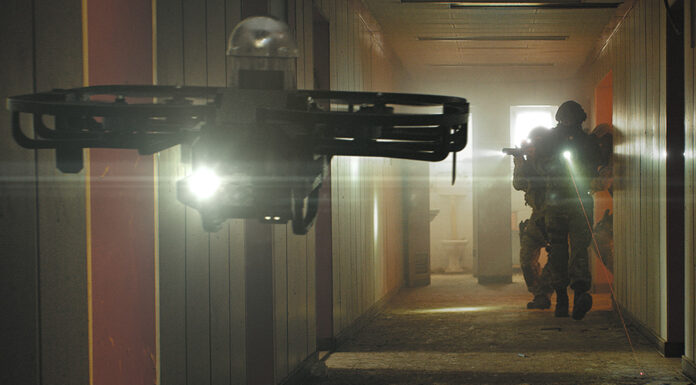Even with the most advanced technology in C4ISR available in OIF, the surprisingly ultra-rapid advance of US led coalition ground forces, often left division, corps headquarters out of the communications loop. In part, the higher command level had anticipated this trend, based on experience in 1991 Desert Storm. As a lesson, tactical commanders were trained to think and act independently making decisions during the ever changing combat situation. The German Auftragstaktik (Mission control), leaving the tactical commander sufficient leeway to act on his own initiative within the general mission framework, has long proved its effectiveness in fast moving mobile combat operations. The Israeli army has near perfected this doctrine in two of the Arab-Israeli lightning wars, in 1956 and 1967.
The concept of Net Centric Warfare has tremendous potential in placing the right tools for seamless mission control in the hands of future military commanders. NCW can link disparate portions of the shifting battlefield in constant “live feed” commentary both up and down the command ‘Grapevine’. In principle, NCW integrates a wide array of sophisticated elements, developed on the latest hi-tech state-of-the-art technologies.
While the Global Command and Control System-Army ( GCCS-A) is designed for communications interoperability at the higher command echelons, the new, mobile, Force XXI Battle Command Brigade and Below (FBCB2) and Blue Force Tracking (BFT) network provides interoperability at tactical command level. The FBCB2 system integrates location data from a position locating guidance radio (PLGR) into a computer housed digital terrain map display monitor. To facilitate message handling, the system uses a messaging format and delivery database as well as graphic display of important tactical information. A brand new system, so-far operated solely by 4th US Mechanized Infantry Div uses a data radio Enhanced Position Locations Reporting (EPLRS) system. Based on synchronized radio transmissions, EPLRS provides near real- time secure data communications, identification, navigation, automatically monitoring of friendly forces movements and locations.
In theory, the NCW system should have enabled hitherto unavailable combat control and rapid information sharing process at all levels of command through its: ” ability to move ‘real-time’ intelligence rapidly from ‘sensor’ to either analytical decision levels or directly to the ‘shooter’, in the words of Brigadier Dennis C. Moran director J-6 US Army CENTCOM. Indeed, CENTCOM headquarters did have a common operating picture of both ‘blue’ and ‘red’ forces most of the time during OIF, but the system was not free of flaws after all.
First of all, the age old principle in the notorious ‘Murphy’s Law’ still applied in OIF: “it is not if the technology will fail but when it will fail” that caused commanders headaches. According to after action reports, problems were still encountered integrating the Army Battle Command System (ABCS). In spite of the sophisticated technology, not all radios could ‘talk to each other’. The US Marine Corps has its own set of digital command and control devices, all different from the US Army.
Two examples could indicate this clearly:
-
The serious fratricide in northern Iraq when US Navy jets mistakenly attacked a Kurdish convoy led by US Special Operation Forces (SOF) revealed that: “A following investigation revealed that the mistake was caused by a simple mix-up: the radios carried by the SOF were compatible only with USAF aircraft but not with US Navy jets which had attacked them!“
-
The mistaken artillery barrage, which hit the US marines at Nasiriya bridge: “On March 27 another ground B+B incident caused 37 casualties among the US marines of 2nd Battalion 8th Marines. Although the Marines had some of the most sophisticated equipment to prevent such a tragic accident, including thermal imaging, night vision gear and computers, to keep track of each other’s movements, even this hi-tech equipment failed to prevent such a tragic event. The 2nd Battalion command post called for artillery support near An Nasiriyah bridge, but the shots fell short, exploding among the Marines with devastating results. Just then a communication break happened, while radio operators were frantically trying to call off the fire in vain. In the midth of the chaos, shells kept exploding for 90(!) minutes, until finally contact was re-established, but the damage was already done.“
Unfortunately, this goes even further. For example, many of the current generation tactical radios are still not fully compatible, or adaptive enough to support the advanced reporting systems. Cross-band digital communication communications is difficult and requires different radio equipment for frequency bands used. This becomes extremely problematic in fast moving operations, where mobile tactical command groups normally, restricted in space, are already overloaded to capacity with critical equipment.
Additional parts of this article:
- Operation Iraqi Freedom C4ISR Lessons Learned
- Combat Implementation of the NCW Doctrine part I
- Combat Implementation of the NCW Doctrine part II
- Tactical C3 Performance
- Mobile Command Post Operation
- Tactical Operations Center Performance
- Beyond Line-of-Sight Communications
- Battle Command on-the-Move



















